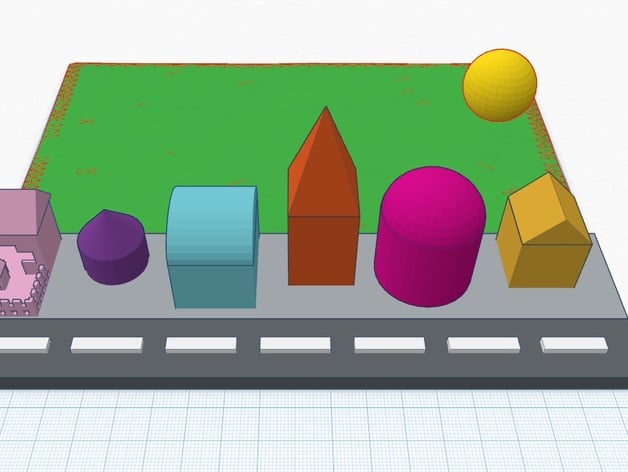
Volume of Buildings on a Street
thingiverse
This is a project for geometry students to discover through building composite figures that resemble a street. Print Settings Printer Brand: MakerBot Printer: MakerBot Replicator (5th Generation) Rafts: Yes Supports: No Resolution: Standard Infill: Use a low infill for prototyping to save time and resources. Notes: For optimal results, use a low infill percentage for initial prototypes, then increase the infill percentage for final versions. How I Designed This I created a level plane as the base for composite figures (buildings) by combining multiple shapes. Then I combined different shapes to create five distinct buildings with varied dimensions, recording length, width, and height to calculate each building's volume. Custom Section Overview & Background: Enhancing understanding of area and volume through technology and real-world applications. Objectives: Students will be able to: Solve everyday problems using composite geometric figures' volumes. Create a 3D "block" using multiple shapes. Audiences: Geometry students following Common Core Standards. Subjects: Math, Technology, Art, Computer Graphics. Skills Learned (Standards): G.GMD.3: Apply volume formulas for cylinders, pyramids, cones, and spheres to solve problems. G.MG.1: Use geometric shapes and their properties to describe objects. Lesson/Activity: Anticipatory Set: 1) Students examine an image of a house on the board. a. Question: Describe the house using 3-dimensional figures. 2) Students look at an image of the Empire State Building on the board. a. Question: Describe the Empire State Building using 3-dimensional figures. Definition: A composite geometric figure consists of two or more 3D shapes, such as a table made from rectangular prisms. Procedure: 1) Students focus on the model provided by the teacher, which features "buildings on a street" created from composite figures. 2) The teacher explains how they used tinkercad to create the model and provides a brief tutorial on its use. 3) Students work in groups to create five composite geometric figures (buildings). 4) Once complete, students calculate each figure's volume by summing the volumes of individual shapes using dimensions from tinkercad. 5) Students record their findings and print their creations using a 3D printer. 6) Partners collaborate on a handout to reinforce knowledge of calculating composite geometric figures' volumes. Duration: Approximately 42 minutes Preparation: Prior Knowledge: Students should already be familiar with: - Identifying 3-dimensional shapes, including spheres, hemispheres, cylinders, and more. - Calculating the volume of various 3D shapes. Technology/Resources Prerequisites: Access to a computer Create a tinkercad account Design new creations Rubric & Assessment: Possible grading rubric below (10 points) Students followed construction rules for their figures. (50 points, 10 points per figure) Equations and calculations for each shape are accurate and well-written. (10 points) Neat presentation of the design. (10 points) Correct answers to worksheet questions. (20 points) Participation in group work and class discussions. Handouts: Homework includes a worksheet to reinforce concepts learned during this lesson.
With this file you will be able to print Volume of Buildings on a Street with your 3D printer. Click on the button and save the file on your computer to work, edit or customize your design. You can also find more 3D designs for printers on Volume of Buildings on a Street.
